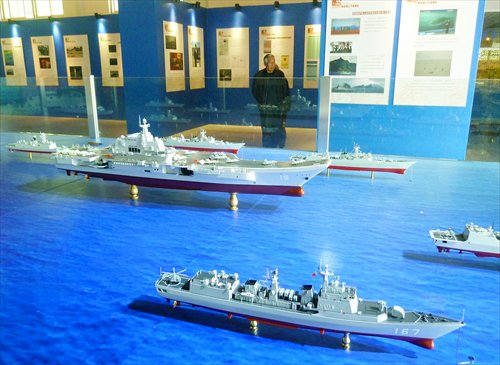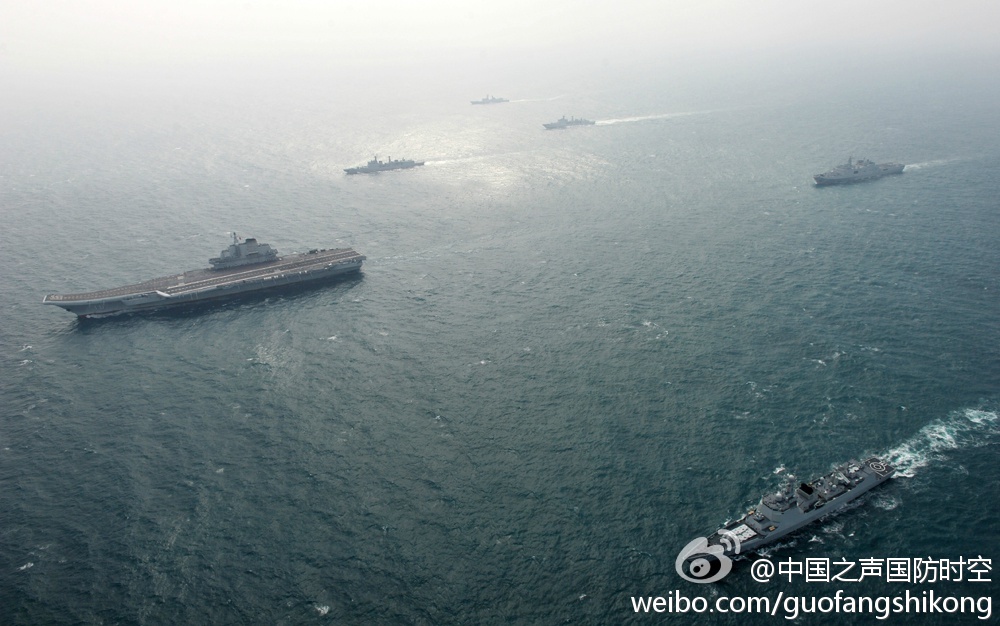
Posted on 12/01/2014 7:52:46 AM PST by sukhoi-30mki
Since China deployed the Liaoning, an aircraft carrier purchased from Ukraine and later refurbished and relaunched by the Chinese navy as a training carrier, speculation has swirled around the construction of a homegrown aircraft carrier.
Although Chinese authorities have never openly confirmed whether a homemade carrier is underway, they have also never denied it.
China's military officials have given some clues, however. Ministry of National Defence spokesman Yang Yujun said last August that although the Liaoning is China's first aircraft carrier, "there will surely be more in future." He said that China will consider the development of aircraft carriers in accordance with its national defense needs, leading many to wonder how many carriers China is planning to build.
Military experts confirm that a country needs at least three carriers to form a basic battle force. Du Wenlong, a research fellow at the PLA Academy of Military Science, says China should deploy at least that amount. With three carriers, one is always available for operational missions, while the second is used for training and the third is resupplied and retrofitted.
Du also said that most missions require at least two carriers working together.
Another view goes that China should deploy three carriers in the East China Sea, South China Sea and waters in the north respectively. The fleets for each of those areas should build a carrier task force, while the Liaoning should be used for day-to-day training. An article appearing in Russian media this February said that China plans to introduce four carriers, including the Liaoning.
The Canada-based Kanwa Defence Review predicts that it may require six years for China to finish building its first homemade carrier, although China has the capability to build two at once.
Currently, it is widely believed that China will build at least two more domestic aircraft carriers, the first of which will be designated Type 001A. Kanwa Defence Review, citing official sources from the Chinese city of Dalian, said that a ceremony celebrating the cutting of steel plate for aircraft carriers was held in the Dalian-based China Shipbuilding Industry Corporation at the end of 2013, marking the beginning of the construction of China's first homegrown aircraft carrier. The article also said that the Jiangnan Shipyard in Shanghai will build the second domestic carrier.
From June 6 to 8, a model of an aircraft carrier, capable of carrying large numbers of aircraft and equipped with a catapult system, was shown at a shipping exhibition in Guangdong Province, sparking speculation that it might be the model for China's second domestic carrier.
Although the model, with a hull humber 18, might just be one of many possible designs not actually under construction, it serves as an indicator of China's naval ambitions. Few doubts China's ambition to build a domestic carrier.

A visitor watches miniature models of a combat fleet, with aircraft carrier the Liaoning at center, at a defense exhibition in Nanjing, Jiangsu Province, on April 4. Photo: CFP
Technical obstacles
Aircraft carriers can be divided into three types according to their size. Supercarriers are the largest type of aircraft carrier, usually displacing over 60,000 tons, represented by the US Navy's Nimitz-class. Carriers with a displacement of 30,000 to 40,000 tons are standard carriers, while light carriers are usually less than 30,000 tons.
Experts say that China's first domestic carrier, like the Liaoning, might be standard in size. Yin Zhuo, a naval expert, said that it cannot be a supercarrier, since they are too costly and technologically complex for China.
Another issue at the center of speculation is whether the new carrier will be nuclear-powered. Nuclear-powered aircraft carriers have been the backbone of the US Navy since 1961, when it deployed the Enterprise, the world's first nuclear-powered aircraft carrier. The US Navy believes that there are many advantages to using nuclear carriers over conventional carriers, since a similar amount of nuclear fuel can provide millions of times more energy than coal or oil, with the high power density allowing more space for fuel, ammunition and other supplies.
Technical complexity and safety concerns, however, are the major drawbacks of nuclear carriers. According to reports, the engine crew of Charles De Gaulle, a 38,000 ton nuclear-powered French aircraft carrier launched in May 1994, received five times the allowable annual radiation dose due to its problematic nuclear reactor. This is allegedly also one of the major reasons why the planned French aircraft carrier PA2 isn't nuclear-powered. The Admiral Kuznetsov, the only operational aircraft carrier in the Russian navy, also uses conventional power.
Experts believe that China is not likely to use nuclear power on its first homemade aircraft carrier. Although China has developed nuclear weapons, the use of nuclear-power plants has been confined to its submarines. None of China's surface warships are currently nuclear-powered, while, according to China Aviation News, China's recently developed R0110 heavy gas turbine is capable of propelling medium conventional carriers.
But this doesn't mean that nuclear power won't be used in the future. According to foreign media, China attempted to acquire the nuclear technology from the Soviet carrier Ulyanovsk at the beginning of the 1990s when Ukraine's economy was at its worst. Military experts predicted that nuclear power might be used in China's second homemade aircraft carrier.
The system used for the launch and recovery of aircraft is one of a carrier's core technologies. The catapult system used in the US Nimitz-class carriers is known for its superior power and flexibility, but is more costly and technologically complex than conventional systems. China's Liaoning uses a ski-jump system which is less costly but places limits on aircraft size, payload and fuel load.
China's military engineering departments have debated which system to adopt in its homemade carrier. Li Jie, a military expert, said that if the carrier is based on the Liaoning's design, it will likely use a ski-jump system. Some reports, however, have said that China has acquired catapult technology to use in future carrier models.
Building a battle group
The composition of Liaoning's carrier battle group has also attracted speculation. A carrier battle group typically consists of an aircraft carrier and a large number of escorts, which together define the group. In US Navy air operations, a carrier battle group usually consists of one aircraft carrier, two guided missile cruisers, two destroyers, one frigate, two attack submarines and a supply ship.
On October 27, the Liaoning returned to its home port in Qingdao after a half year of maintenance. During the trip China's CCTV revealed an image of the Liaoning battle group, in which the aircraft carrier was sailing with at least eight surface vessels and submarines in formation.
This was the first time that Liaoning appeared in public with its battle force, which experts say is open to changes in future. China deployed its first carrier task group in December 2013, when the Liaoning left its home port of Qingdao in East China's Shandong Province for the South China Sea. It was then escorted by two missile destroyers, two missile frigates, and a supply ship.
In less than a year, the size of Liaoning's escort group grew from five ships to eight. But just one battle group won't be enough for China's future carriers. China is manufacturing large numbers of 052D type destroyers and 054A type frigates to train alongside the Liaoning, so that once future carriers are commissioned, escorts will be readily available.
As for the geographical range for deployment, experts say the South China Sea is an ideal place. The heightened territorial tensions over the South China Sea, host to a complex web of sovereignty claims, call for a carrier to protect China's maritime rights, Li Jie said.
There have been several reports that the Chinese navy is already strengthening its forces in the South China Sea. In March, the Kunming, the first ship of a new class of missile destroyer, was commissioned and delivered to the South China Sea Fleet, becoming the fleet's third guided missile destroyer.
In total, 17 new warships were reportedly commissioned in 2013, with the majority bound for the South China Sea Fleet.
Although Chinese authorities have claimed that China's aircraft carrier is not being built with a specific target in mind, military experts said that to maintain China's maritime rights, Chinese navy will have to break the so-called "first island chain" blockade to gain access to the Indian Ocean.
The Chinese navy's experience in testing and training on the Liaoning will have important implications for China's future homemade carriers. Experts say China's military logistics infrastructure will soon be mature enough to allow China's new homemade carrier, once completed and commissioned, to form a powerful battle force.
China Newsweek

The Chinese seem to be using a “ski jump” flight deck rather than the angled flight deck catapult arrangement on US carriers. Would this mean that their carrier aircraft must have STOL capabilities that might compromise their speed and weapons carrying capacity?
The Chi-Coms have to defend themselves from little nations that might try to stop the Chi-Coms from taking their territory.
Aircraft carriers have been around for almost 100 years and China just got one ,OK sounds really dangerous
That is precisely what it means.
Hmmm
Japan is smirking about the Chinese carrier, the trainer not even home-grown and the others based on copying other nation's designs.
Japan commissioned the world's first aircraft carrier in 1922 (from keel-up), the Hosho which saw battle in WWII, scrapped in 1946. Yup, almost 100 years have passed.
They use the Russian STOBAR system. Short TakeOff But Arrested Landing.
As for load, recall interview who Russki Admiral who said the Su-27 was limited to 85% of usual max gross TO weight when operating from the Kuznetsov
Disclaimer: Opinions posted on Free Republic are those of the individual posters and do not necessarily represent the opinion of Free Republic or its management. All materials posted herein are protected by copyright law and the exemption for fair use of copyrighted works.